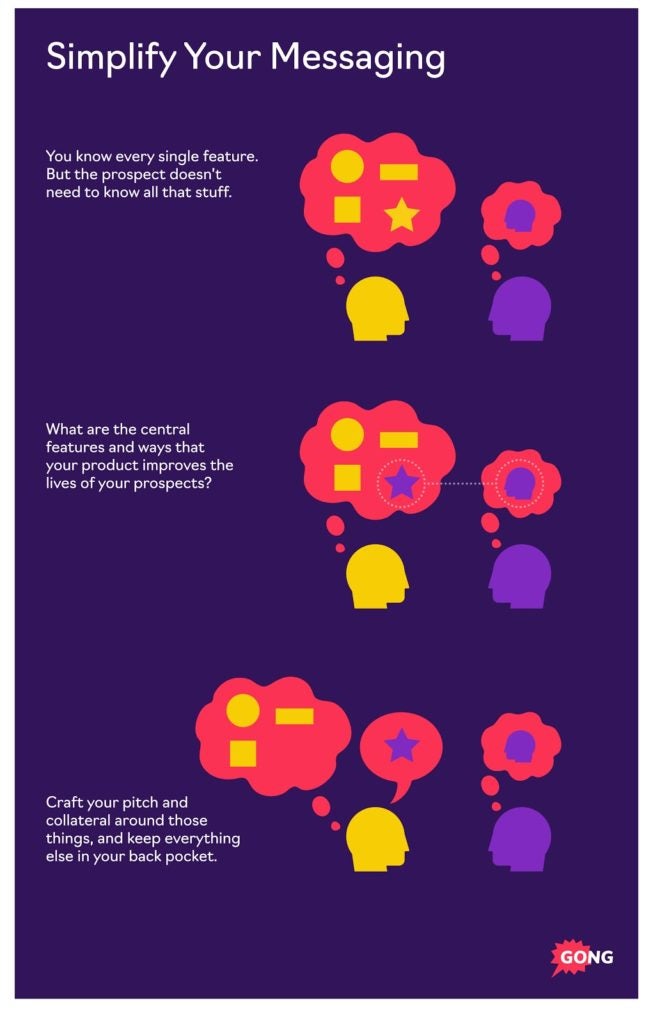Scott Leese: How to Humanize Yourself as a Sales Leader
Why is it so crucial to simplify your sales messaging?
How do you use data to iterate your strategy?
Why is vulnerability the missing link for most sales leaders?
On a recent episode of the Reveal podcast, we connected with Scott Leese for answers to these and other questions that are top of mind for revenue leaders.
Scott has over a decade of sales leadership experience, is the former SVP of Sales at Qualia, and is the founder of the Surf & Sales conference.
Here are the key takeaways and highlights from that episode.
Dealing With Failure
The failure rate in sales is so much greater than it is in sports—it builds up some resiliency and some mental toughness for sure. And I think if you haven’t gone through some of that in an athletic forum, it might be a little more difficult.
I don’t know, because I grew up playing sports. But I feel like it gave me an advantage in bouncing back and shaking off the losses and the mistakes.
As a basketball player, if you make 50% of your shots, you’re considered to be a pretty damn good shooter. Can you imagine making 50% of your sales? You make 100 calls and 50 of them turn into deals? You’d be an absolute hero. You’d be a legend, right?
Nope, it doesn’t work that way.
You have got to work on your mental toughness and your self-confidence and your self-esteem…because it’s very, very difficult, and very easy to get down.
Simplify Your Messaging
To be perfectly candid with you, it’s not usually the sales team that has this problem. The sales team knows it. You know who has the problem? The owner has the problem. The founder has the problem. And the VP of Product and the VP of Engineering have the problem.
Because they know all this shit that the product can do. They know every single feature and every single thing it can do. But the prospect doesn’t need to know all that stuff.
The first thing to do and the hardest thing to do is explain to the founder and the people who built the product that, “Hey, your baby is not exactly the cat’s meow. Nobody cares about all these things.” So the hardest thing to get them to understand is, “No, that feature, that piece of the product is not important enough. We’re putting that to the side. If somebody asks about that, boom! I got it in my back pocket and we can talk about it.”
So when I show up, I’m usually like, “Okay, give me a rundown of how you’re pitching and presenting this.” And it’s like an encyclopedia length, right?
“Alright, we’re throwing out 90% of that. What are the three or four main central features and ways that your product improves the lives of your prospects? We’re going to craft our pitch and our collateral around those things, and keep everything else in our back pocket.”
The big win to me is going in, taking this complicated idea—this complicated product, and finding a way to simplify, simplify, simplify the messaging.

Data Breakout—The Science Behind Simplifying Messaging
Neuroscientists say our brains have a built-in stopwatch that ends around 10 minutes. University of Washington Medical School molecular biologist, John Medina, says people tune out of a presentation in the first 10 minutes. “The brain seems to be making choices according to some stubborn timing pattern, undoubtedly influenced by both culture and gene.”
Apple is famous for this approach, and they use it in their annual product announcements—one of the most anticipated presentations in Tech. Every 10 minutes or so a new speaker joins the stage to change the topic and discuss a new product or feature.
Our Gong Labs confirms this approach, finding that successful deals only pitch for nine minutes during the intro sales meeting, compared to 11 or more for unsuccessful deals.
Notice these presentations—Apple’s and sales—aren’t nine minutes in total , but instead are designed to have short “chapters” of focus to keep the audience’s attention.
So the data is there, and it appears that a shorter, more concise sales presentation is the best route.
For more insight on how to mirror this approach on your sales calls, read Great Salespeople Never Pitch For More Than 9 Minutes—Here’s Why.
Learning What Works
The truth bomb that most VPs of Sales probably will lie about…
”We don’t know.”
I don’t know. I’m taking my experience and all the data points that I have, and putting my best foot forward and giving it my best guess.
But the truth is that we don’t know. And the truth is that I never nail it 100% right the first, second, or third time. I just have to get close enough to give myself a chance to continue to get feedback and get engagement from the people that I talk to. And work with the couple early AEs that I have, and get their feedback.
This is a living breathing document—the sales script and the messaging. Until we’ve got a couple of deals in, and until I feel like, “Okay, this is kind of as good as it gets.” And then I’ll sit with that for a while. After year one, we take a look at it. And it’s like, “What can we throw out? How do we simplify this even more?”
And that process of refinement is something that I would do in my organizations all the time. To never likely come up with one way to pitch it, and then that’s it for eternity. No. We’re moving around. We’re figuring out what resonates more or less. How do we get to the point faster? These kinds of things.
And you’re measuring that with data. If you’ve got tools to help you measure that, great! You should be utilizing those. How many calls and how many emails does it take to get somebody on the phone, and then to build interest, and then to set demos, and to hold the demo? You know, all the normal KPIs.
You’re measuring the effectiveness of your pitch and your scripts all the time. And you should be making adjustments based on what the data tells you.
In the early days, you’re trying to figure out and really lock in your ICP, your ideal customer profile. You don’t really know. You’ve got a hunch, and you’ve got maybe some experience on your side, but you know, you’re taking a guess.

The Importance of Vulnerability
I think there’s a tendency for sales leaders to want to be Superman or Superwoman. “I’m indestructible, and I move a thousand miles an hour, seven days a week, 365 days a year. If something bad happens in my life, I just brush it off and I’m fine.”
So I try to explain to some of the leaders that I work with that if you really want to get to know the people that you work with, you also have to be willing to allow them to get to know you. And that is one of the best ways and the fastest ways to build trust that I know.
I have been through Hell and back in my life, and I think the smartest thing that I did a long time ago was just to own it. Just talk about it and be open about it. I think that has helped make me a little bit relatable to people that I work with.
If I compare myself to this person who is working 24 hours a day, what am I going to end up doing to my mental health? I’m going to destroy it.

Helping Others Find Their “Why”
If you want to understand your people’s Why…and how you can best motivate them, you’ve got to put in the time.
You don’t have to necessarily block off 30 minutes or an hour for a one-on-one. Just walk around the office for five minutes and be like, “Hey Sheena, how’s it going? What are you working on?”
There’s no shortcut. You’ve got to spend the time with your people. And you’ve got to listen to them. You’ve really got to listen to them, and be willing to care about them more than you care about yourself.
I don’t buy the whole, “Oh, it’s going to take me a couple of years to figure out what I really want to do.” Bullshit! What do you want to do with the rest of your life? You better have an answer! And everyone does.
Every single person has a Why. Why they’re in that role right now. Why they’re at work. Why they’re picking up the phone.
Making a Real Impact
There is absolutely nothing better than having one of those five-minute Why conversations. Or giving somebody advice, and just watching the lightbulb go off in their head. That switch gets flipped.
And them coming back to you a day, a week, a year, five years later, and still pointing to you as the person that made the largest impact on them and their life and their career.
There is no better reward than that. It’s the best feeling that I’ve ever experienced. And I’m eternally grateful for everybody who has given me a chance to play that role and have that impact on their lives. And then give me the feedback, even. Those are the moments that sustain me and keep me going, that have kept me always coming back to being a sales leader.
My job is to help you get where you want to go. That’s what it has to be about. My Why and my goal now is to leave a legacy.
Why Scott Founded Surf & Sales
I want deep connection. I want to make an impact. I want a conference to be a little bit of a vacation as well as a learning opportunity. I don’t want to go to the same city that I’ve been to God knows how many times in my life.
It came to me while I was surfing in Costa Rica. Why doesn’t anybody do it here? Like, literally right here. That’s kind of how it was born.
Can I find 15-20 people? That’s it. Super exclusive for 15-20 like-minded people who are going there to learn, share ideas. Some of whom are SDRs, some of whom are CEOs. I’ve had VPs of Sales, sales managers, VPs of Operations, VPs of Customer Success. And everybody can learn something from each other and their experiences.
The Number One Sales Leadership Skill For 2020
I think relationship building with their team members—that’s the skill. How do I cultivate stronger relationships with the people who are working with me, and for me?
If you were to leave today to go to some other place, and you don’t have people that would follow you, you’re not doing your job right. You might have a legacy, but your legacy sucks.
Subscribe to Reveal: The Revenue Intelligence Podcast
Every week, we interview senior revenue professionals who share their insights on how they leverage revenue intelligence to drive success and win their market.
You’ll hear how modern go-to-market teams win, close revenue with critical deal insight, and execute their strategic initiatives—plus all the challenges that come along with it.
Listen now at gong.io/podcasts.

